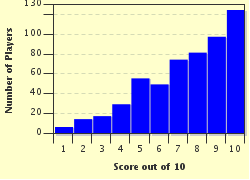Quiz Answer Key and Fun Facts
1. Three chemical symbols for elements are used in this joke: He, Cm & Ba. "I helium (He) when they're sick" said one doctor. "I curium (Cm) too" said another. "Aha" said the third man in the group, "if you two fail, I...(Ba)". What is this last word? (Hint, if you're struggling, read the joke aloud)
2. A very bad chemical pun: "What is green and very, very large?" (In fact, 6.02 x 10 to the power 23).
3. Now you have to finish the joke! A neutron walks into a bar, orders a beer and asks how much it will cost. What is the barman's response, which is based upon a key characteristic of a neutron?
4. Two atoms meet at the bar. One says to the other, "You look sad, are you all right?" "No, I've just lost an electron!" The first says "Are you sure?" Which of the following options is the correct punch line?
5. Werner Heisenberg, the scientist famous for his Uncertainty Principle, was out for a late night drive when he was pulled over by a traffic policeman. The cop then asks Heisenberg "Do you know how fast you were going?". What was Heisenberg's reply?
6. Formaldehyde has a molecular formula of CH2O. But as a pun, what might CH2O also represent? (Hint: Read it as C-H2O)
7. Helium walks into a bar and asks for a beer. The bar tender says "We don't serve noble gases like you in here." What's the punch line to this joke?
8. During a routine car inspection, a man was arrested for possessing sodium chloride and a nine-volt device. What was he charged with? (pun intended)
9. Another chance to guess the punchline! A photon checks into a hotel. The manager asks him if he needs any assistance with his luggage. How does the photon respond? The answer is related to the nature of a photon!
10. That great English spy, 007, went to visit his brother who was living in far northern Canada. How did James' brother introduce himself? (Choose the most appropriate answer given the location of their meeting!)
Source: Author
MikeMaster99
This quiz was reviewed by FunTrivia editor
WesleyCrusher before going online.
Any errors found in FunTrivia content are routinely corrected through our feedback system.

